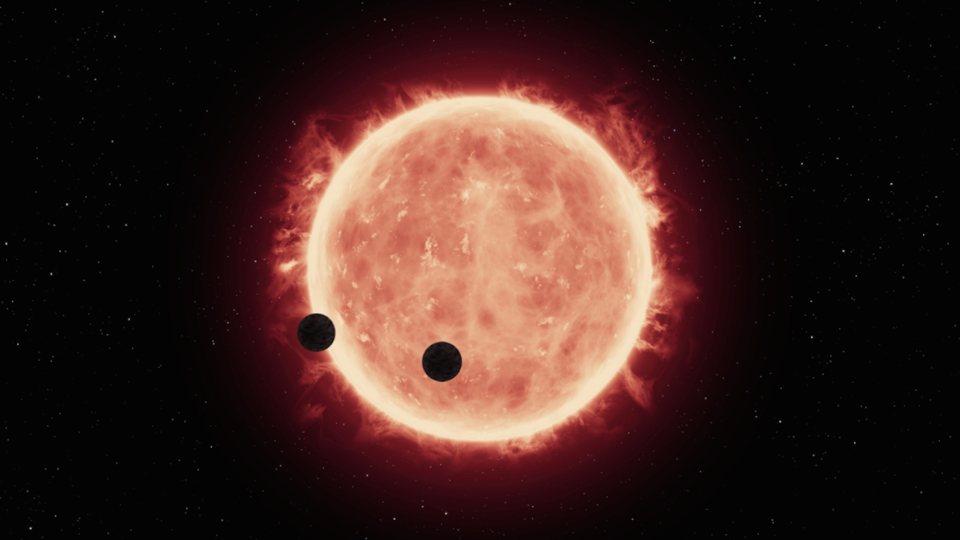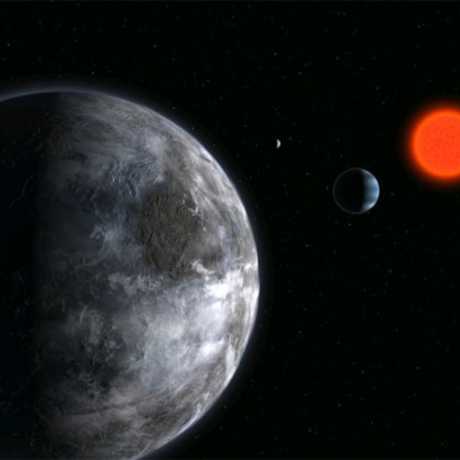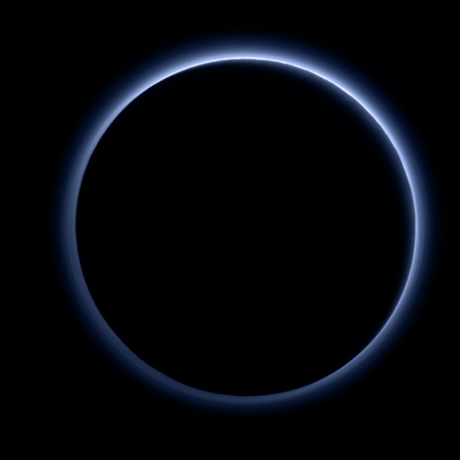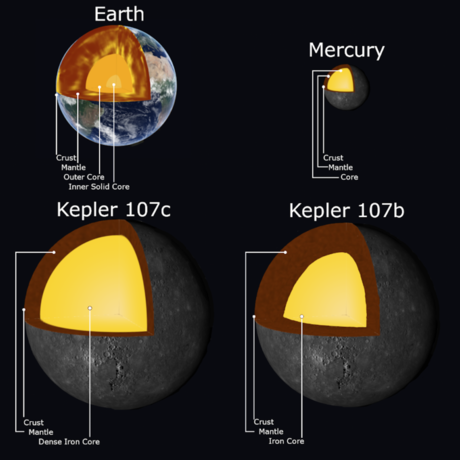Science News
Space Friday: MeerKAT, Rocky Exoplanets, and X Marks the Spot

Seeing the Universe Through the Eyes of a MeerKAT
It's not even finished yet, but South Africa’s new MeerKAT radio telescope array is already the most powerful radio telescope in the southern hemisphere. Rather than a single dish, such as the Arecibo Radio Telescope in Puerto Rico or the new Five-Hundred Meter Aperture Spherical Telescope (FAST) in China, MeerKAT is a network of smaller dishes which combine their capabilities to do the equivalent work of a single large dish. So far, only 16 of the 64 planned dishes of the system are operational, but MeerKAT has already been used to take a First Light image, giving scientists an idea of what they might expect when it’s complete.
“First Light” is the term ceremoniously given to the first time a telescope is used to capture an image of the sky, and MeerKAT’s first image of celestial radio sources revealed more than 1,300 galaxies where only 70 had been known before, all contained in a tiny part of the sky comprising less than one-hundredth of a percent of the celestial sphere.
Next year, MeerKAT will be integrated into the multinational Square Kilometer Array (SKA), consisting of thousands of dishes and receivers of various types clustered mostly in remote parts of South Africa and Australia, isolated as much as possible from radio noise. When completed around 2024, SKA will have a total collecting area of (surprise) one square kilometer, or a million square meters (0.4 square mile). That would simulate a giant dish with a diameter of 1,128 meters (3,702 feet), and ultimately have a resolution 50 times that of any instrument currently in use.
Unlike optical telescopes, radio telescopes map out sources of radio waves, which are generated by objects such as galaxies and various types of stars, enabling scientists to detect objects and structures that are otherwise invisible. Eventually, scientists hope that SKA will help unravel the mysteries of dark matter, the origin of magnetic fields, and the source of cosmic rays—as well as aiding our understanding of the accelerating expansion of the Universe.
Originally designed with 20 dishes, MeerKAT was initially known as the Karoo Array Telescope (KAT), after its location in the Karoo region of South Africa. It was renamed when the South African government released further funding to build more dishes, totaling 64. In Afrikaans (the third most-spoken language in South Africa), the word for “more” is “meer,” so it was only natural that the system be called MeerKAT (“more KAT”), which also happens to be the name of the mongoose-like animal (Suricata suricatta) found in Karoo. Famously, these lovable critters stand guard over their colonies, sometimes in groups, combining the acuity of many alert pairs of eyes to gather information—not unlike the radio dishes of the high-tech facility named after them.
Timon would be proud. –Bing Quock
Rocky Planets in the Habitable Zone. But Life?
Earlier this week, NASA announced the confirmation of more than 100 newly-discovered exoplanets. And while Kepler’s K2 Mission is delivering the quantity of exoplanet findings, the Hubble Space Telescope is offering a bit of quality. This week, researchers from Massachusetts Institute of Technology (MIT) reported that two planets in the TRAPPIST-1 system—about 40 light years away—are rocky planets, increasing the likelihood of their habitability.
As we reported here earlier this year, TRAPPIST-1, an ultracool brown dwarf, has three planets in extremely close orbits around it, but given its “ultracool” temperature, they lie in the star’s habitable zone. This past May, scientists had the extraordinary chance of viewing two of those planets close-up with Hubble, when they happened to be transiting their star at the same time.
The researchers only realized this event would occur two weeks prior and quickly requested time on Hubble. On May 4, Hubble captured the double transit, the moment when the two planets almost simultaneously passed in front of their star, recording a combined transmission spectrum. “The data turned out to be pristine, absolutely perfect, and the observations were the best that we could have expected,” says team leader Julien de Wit. “The force was certainly with us.”
The dips in starlight that Hubble captured were observed over a narrow range of wavelengths that turned out not to vary much over that range. If the dips had varied significantly, de Wit says, such a signal would have demonstrated the planets have light, large, and puffy atmospheres, similar to that of the gas giant Jupiter. But that’s not the case. Instead, the data suggest that both transiting planets have more compact atmospheres, similar to those of rocky planets such as Earth, Venus and Mars.
“Now we can say that these planets are rocky. Now the question is, what kind of atmosphere do they have?” de Wit says. “The plausible scenarios include something like Venus, with high, thick clouds and an atmosphere dominated by carbon dioxide, or an Earth-like atmosphere dominated by nitrogen and oxygen, or even something like Mars with a depleted atmosphere. The next step is to try to disentangle all these possible scenarios that exist for these terrestrial planets.” (The team is looking for funding for this next step. Click here for more information.)
But for life to exist on one of the rocky planets may still be quite a challenge, say astrophysicist Joanna Barstow. As the planets orbit very close to their star that may mean the radiation coming off the star may strip their atmospheres away entirely, making it extremely difficult for organisms to thrive, particularly as both planets are tidally locked, meaning they have permanent day and night sides.
“Of course, our ideas of habitability are very narrow because we only have one planet to look at so far, and life might well surprise us by flourishing in what we think of as unlikely conditions,” Barstow says. –Molly Michelson
Putting the X in Our GalaXy
A study published this month in Astronomical Journal revealed the strongest evidence yet of an X-shaped structure in the central bulge of the Milky Way galaxy. The paper is the culmination of work between two scientists who began their collaboration through, of all places, Twitter.
“Scientists on Twitter often share sneak peeks of interesting results or pretty pictures,” said Dustin Lang of the University of Toronto who in 2015 tweeted re-analyzed galaxy maps based on data from NASA’s Wide-field Infrared Survey Explorer (WISE) as part of a project to make galaxy maps interactive. “I released the results in the hope that they would be useful for other scientific studies.”
And indeed they were. When postdoctoral researcher at the Planck Institute for Astronomy in Heidelberg, Melissa Ness, saw the images, she recognized a faint X-shape structure in the central bulge of the Milky Way, something that had not clearly been defined before, and contacted Lang.
Previous studies, including observations of other galaxies and computer models, suggested the X-shape within the Milky Way bulge. In fact, noticeable dips in the number of stars near the center of our galaxy make up the intersection of the two arms of the X.
Immense clouds of gas and dust within our galaxy make exploring the structure of the Milky Way or peering at the galaxies beyond challenging because visible light cannot pass through them. However, WISE scanned in infrared light, which can pass through these obstructions and give us a new perspective of previously hidden formations. The finding is a major clue in retracing our galaxy’s evolution.
“The shape of the bulge tells us about how it has formed. We see the X-shape and boxy morphology so clearly in the WISE image and this demonstrates that internal formation processes have been the ones driving the bulge formation,” explained Ness. “It is also evidence that our galaxy did not experience major merging events since the bulge formed. If it had, interactions with other galaxies would have disrupted its shape.”
Lang chalks up his study as a win for astronomy, social media, and open science. “I really like the fact that this study happened at all—to me, it’s an example of the interesting, serendipitous science that can happen when people publicly release their data and try to communicate their results to the public and other scientists.” –Elise Ricard


